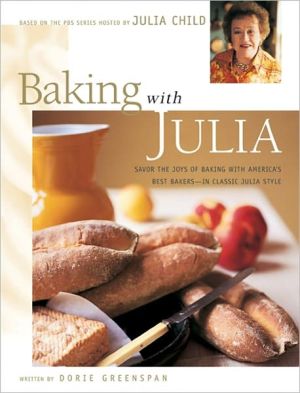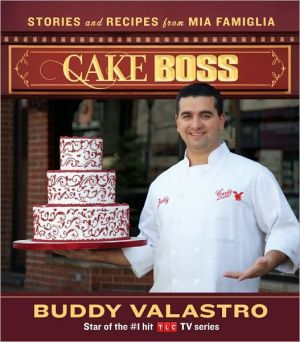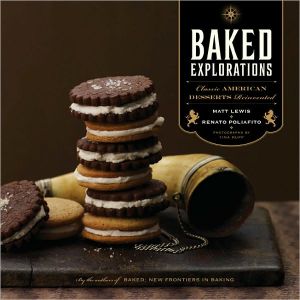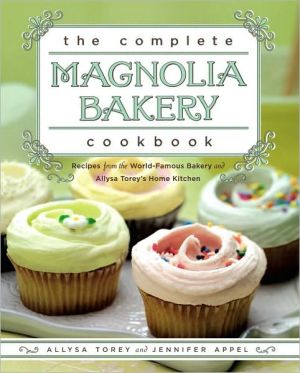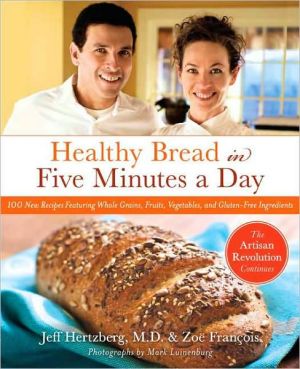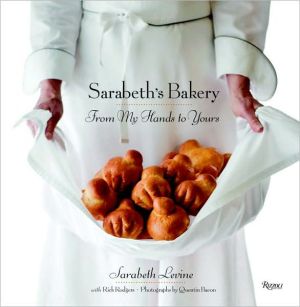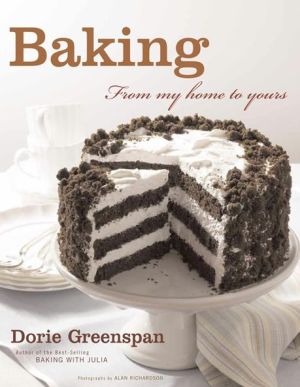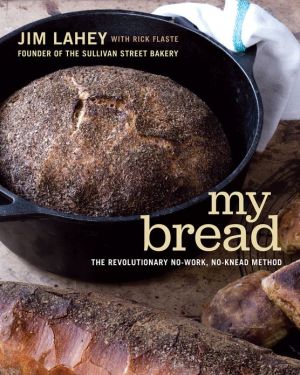Baking with Julia: Savor the Joys of Baking with America's Best Bakers
Baking with Julia Nothing promises pleasure more readily than the words "freshly baked." And nothing says magnum opus as definitively as Baking with Julia, which offers the dedicated home cook, whether a novice or seasoned veteran, a unique distillation of the baker's art. Baking with Julia is not only a book full of glorious recipes but also one that continues Julia's teaching tradition. Here, basic techniques come alive and are made easily comprehensible in recipes that demonstrate the...
Search in google:
A delightful treasure trove of the baking wisdom of Julia Child, America's foremost culinary authority, covering everything from breads and pastries (both sweet and savory) to cakes and cookies. Richard Flaste Whatever the objectives of the television series may have been, the book, written by Dorie Greenspan in a literate, patient but exuberant style, is more than strong enough to stand on its own. It's the product of a tremendous collaborative effort, yet it achieves a clear authorial tone. To my ear, it sounds as if Ms. Greenspan has spent so much time with Julia Child that she's assimilated her accent and eloquence, although it may be be own natural voice....The 200 recipes are organized as a course in baking, with an early, energetic section on the basic batters and doughs or cakes and pastries. The book moves on to recipes of varying degrees of complexity. In the bread section, you start off easy, with simple compositions, like white bread or a buttermilk loaf for your bread machine, and then it's on to more painstaking creations that might include tricky wild yeast and meticulous braiding.But the book's success is due to more than organization: the text never misses a chance to explain, expand and entertain. The reader is told, for instance, that the molded cookies called "tuiles" are a reference to French roof tiles; chiffon cake was named for the airy costumes of the flappers in the 1920's. And the tutorials that accompany recipes are models of clarity... " —New York Times
Flaky Pie Dough\ Makes enough dough for four 9- to 10-inch tarts or open-faced pies or 2 double-crusted pies.\ Bakers like to talk about the "secrets" of making great pie crusts. In truth, there are tips, but no unknowable secrets and nothing daunting enough to explain why cool, calm, collected types turn nervous at the thought of tackling a pie crust.\ Like the fillings they cradle, crusts have personalities: crisp, tender, and flaky—or some combination thereof. Which traits are dominant is, in good measure, a result of ingredients: Butter is the great giver of flavor and vegetable shortening the flake maker; together they produce a crust both flaky and tender, sweet and full-flavored, the kind most prized by American pie hands. This mixed crust (the best example of which follows) can be used for pies and tarts, sweet and savory, American- or European-style.\ An all-butter doughwill give you a crisp, sturdy crust with little flakiness (unless the butter is left in largish pieces). When prebaked on its own, a butter crust will stand firm against juicy fillings. Handled properly, a butter crust is strong enough to be rolled out and molded into a free-form shape or a galette. For most bakers, an all-shortening crust is usually not an option, because, although it produces lots of flake, it delivers almost no flavor.\ If you could have only one pie dough in your repertoire (heaven forbid), it would have to be this one, the classic dough that earns blue ribbons at county fairs and stars at esteemed pastry shops. The mix of butter and shortening guarantees that the dough will be flaky, flavorful, and tender. You can use this dough to makeany kind of pie or tart, sweet or savory, plain or fancy. It is easy to roll and crimp and is made quickly by hand, in a mixer, or food processor. The recipe is large and can be cut in half or even quartered, but since the dough can be frozen for up to a month, it's practical to make the full batch. You can freeze the dough in disks, rolled out in circles, or already fitted into pie pans or tart molds, ready to go into the oven-without thawing—when you're in a crunch for a crust.\ 5-1/4 cups pastry flour or all-purpose flour\ 1 tablespoon kosher salt\ 1 1/2 sticks (6 ounces) cold unsalted butter, cut into small pieces\ 1 3/4 cups (11 ounces) solid vegetable shortening, chilled\ 1 cup ice water\ To make the dough by hand, mix the flour and salt together in a large bowl. Add the butter and, using a pastry blender (or your fingers, if you prefer), cut it into the flour until the mixture looks like coarse crumbs. Be patient—this takes a while. Break up the shortening and add it in bits to the bowl. Still working with the pastry blender (or your fingers), cut in the shortening until the mixture has small clumps and curds. Switch to a wooden spoon and add the ice water, stirring to incorporate it. Turn the dough out onto a work surface and fold it over on itself a few times—don't get carried away. The dough will be soft, but it will firm sufficiently in the refrigerator.\ To make the dough in a mixer fitted with the paddle attachment, put the flour and salt into the bowl and stir to mix. Add the butter and mix on low until it is cut into the dry ingredients and the mixture looks coarse and crumbly. Add the shortening in small bits and continue to mix on low. When the mixture is clumpy and curdy and holds together when a small bit is pressed between your fingers, add the water and mix only until it is incorporated. Turn the dough out onto a work surface and fold it over on itself two or three times, just to finish the mixing and to gather it together.\ To make the dough in a food processor, start with very cold ingredients and take care not to overwork them. Place the dry ingredients in the food processor fitted with a metal blade and pulse just to mix. Take the top off, scatter the chilled cubed butter and shortening over the flour, cover, and pulse again, working only until the fats are cut in and the mixture resembles slightly moist cornmeal. Add a little of the liquid and pulse a few times, then add more liquid and pulse again. Continue until the mixture has curds and clumps and sticks together when pressed between your fingers. Don't process until the dough forms a ball that rides on the blade—that's overdoing it.\ Chilling the Dough: Wrap the dough in plastic and refrigerate for at least 2 hours or for as long as 5 days. When the dough is thoroughly chilled and firm, it is ready to roll out and use in any recipe calling for flaky pie crust.\ Storing: The dough can be kept in the refrigerator for 5 days or frozen for 1 month. It's a good idea to divide the dough into quarters for freezing since one quarter of the recipe is generally enough for one pie crust or tart shell. Defrost, still wrapped, in the refrigerator.\ Contributing Baker Leslie Mackie\ \ French Apple Tart\ Makes 8 to 10 servings\ This open-faced tart is beautiful. The top is a blossoming rosette of dark-edged, paper-thin apple slices, a pattern considered classic among French patissiers and one that's easier to reproduce at home than you'd think at first glance. Beneath the gossamer blossom is what the French call a compote, a sweet, thick puree of oven-roasted Granny Smith apples. Each forkful delivers the butter and crackle of the crust, the sweetness and smoothness of the puree, and the pure apple flavor of the topping. All this, and the pride of presenting a polished tart any professional baker would be happy to claim.\ 1/4 recipe Flaky Pie Dough, well chilled\ 6 Granny Smith apples\ 3/4 cup sugar\ 1 tablespoon all-purpose flour\ Pinch of cinnamon\ 1/2 cup fresh, fluffy bread crumbs\ 2 teaspoons (approximately) fresh lemon juice\ On a lightly floured surface, roll the dough into a circle about 1/8 inch thick and fit it into a 9-inch fluted tart pan with a removable bottom. Press a little of the overhang against the edge of the pan so that it produces a small ledge protruding over the inside of the pan. The best way to do this is to press the index finger of one hand against the dough running up the side of the pan and use the thumb of the other hand to form the inner ledge by pressing the overhanging dough against the rim of the pan and the top of your inside finger. The ledge will be about 1/2 inch wide. Press it against the edge of the pan to cut off the excess dough. Now, working with your thumb perpendicular to the bottom of the pan, press against the ledge you've created so that some of the ledge's dough is pressed down against the side of the pan and the rest of it is lifted up above the rim of the pan. Use the back of a knife to decorate the edge by pressing it diagonally at each flute or at 1/2-inch intervals around the tart.\ Chilling the Crust Chill the crust for at least 30 minutes.\ Baking the Crust Center a rack in the oven and preheat the oven to 400 F\ Fit a piece of parchment paper or foil into the tart shell and fill with pie weights, rice, or dried beans. Bake for 20 to 25 minutes, until golden brown. Transfer the crust, with the paper and weights, to a cooling rack and let cool while you make the filling. Lower the oven temperature to 375 F.\ Making the Filling Peel and core the apples, cut each one in half, and cut each half into 12 pieces. Put the apples in a large bowl and toss with the sugar, flour, cinnamon, and bread crumbs. Add just a squeeze of lemon juice to start—you'll be able to adjust the flavor later. Spread the apples on a jelly-roll pan and bake for 15 to 20 minutes, or until the apples give up their juices, start to form a sauce, and are soft enough to mash. Scrape the apples into a bowl and mash with a potato masher or a heavy spoon. Don't be overzealous—a few small lumps and bumps will add interest to the filling. Taste and add more lemon juice if you think it needs it, then cool the filling for about 15 minutes.\ Filling the Shell Spoon the puree into the cooled tart shell and smooth the top with an offset spatula. The filling should come to just below the rim you've created. (If you have too much, you can serve the extra as a simple dessert topped with whipped cream.)\ The Topping\ 2 to 3 Granny Smith apples\ 1 tablespoon fresh lemon juice (or more to taste)\ 2 tablespoons unsalted butter, melted\ 1 1/2 teaspoons granulated sugar\ Confectioner's sugar, for dusting\ If you have turned off the oven, reset it to 375 F.\ Peel, core, and quarter the apples (cutting from end to end), then cut them into slices that are between 1/8 and 1/4 inch thick. As you work, toss the slices with the lemon juice to prevent discoloration. Save the smaller pieces from the ends of the apples—they'll make good packing and "even-outers."\ Working slowly and carefully and starting at the edge, arrange the apples in a circle on the puree. The slices should overlap and the points should just touch the shell. Since these will shrink, make a well-packed circle. Lay on another circle overlapping the first by just about 1/8 inch, tucking a few small pieces under the circle to level it and trimming the slices as necessary so that they fit. You'll probably have enough room for two circles and a center rosette. For the rosette, choose a large, thin slice of apple, cut it into a round, and place it, propped up slightly, in the center of the tart. Or, if your apples were small and the opening in the center is too large to be covered by one slice of apple, arrange as many slices as needed to create an attractive rosette.\ With a light hand, evenly brush the apple slices with the melted butter (use a feather brush if you have one) and sprinkle with the granulated sugar.\ Baking the Tart Put the tart on a parchment- or foil-lined jelly-roll pan and bake for 25 to 30 minutes, or until the top is beautifully glazed and the apple slices are edged in black, a stunning effect. Check that the apples are baked through by piercing a couple with the tip of a sharp knife. if the apples aren't baked but the tart is very brown, cover the tart with a foil tent and bake a few minutes longer. Transfer the tart to a cooling rack. Just before serving, remove the tart from the pan and dust its edges with confectioner's sugar.\ Storing This tart is at its prime ever so slightly warm or at room temperature. You can cover any leftover tart tightly with plastic wrap and refrigerate it, but don't expect it to retain its just-baked grace.\ Contributing Baker Leslie Mackie
\ From Barnes & NobleWinner of 1997's James Beard Award for Best Book on Baking and Desserts, Baking with Julia is the companion volume to Child's latest installment of the "Master Chefs" PBS series. A true master class in baking, the book covers everything from rustic breads to delicate cakes and pastry to homey pies and cobblers. Author Dorie Greenspan does an excellent job of conveying Child's basic techniques, refined during her many years of experience, along with recipes contributed by such famous bakers as Flo Braker, Nick Malgieri, and Alice Medrich.\ \ \ \ \ Richard FlasteWhatever the objectives of the television series may have been, the book, written by Dorie Greenspan in a literate, patient but exuberant style, is more than strong enough to stand on its own. It's the product of a tremendous collaborative effort, yet it achieves a clear authorial tone. To my ear, it sounds as if Ms. Greenspan has spent so much time with Julia Child that she's assimilated her accent and eloquence, although it may be be own natural voice....The 200 recipes are organized as a course in baking, with an early, energetic section on the basic batters and doughs or cakes and pastries. The book moves on to recipes of varying degrees of complexity. In the bread section, you start off easy, with simple compositions, like white bread or a buttermilk loaf for your bread machine, and then it's on to more painstaking creations that might include tricky wild yeast and meticulous braiding.But the book's success is due to more than organization: the text never misses a chance to explain, expand and entertain. The reader is told, for instance, that the molded cookies called "tuiles" are a reference to French roof tiles; chiffon cake was named for the airy costumes of the flappers in the 1920's. And the tutorials that accompany recipes are models of clarity... " —New York Times\ \ \ New York TimesWhatever the objectives of the television series may have been, the book, written by Dorie Greenspan in a literate, patient but exuberant style, is more than strong enough to stand on its own. It's the product of a tremendous collaborative effort, yet it achieves a clear authorial tone. To my ear, it sounds as if Ms. Greenspan has spent so much time with Julia Child that she's assimilated her accent and eloquence, although it may be be own natural voice. . . . The 200 recipes are organized as a course in baking, with an early, energetic section on the basic batters and doughs or cakes and pastries. The book moves on to recipes of varying degrees of complexity. In the bread section, you start off easy, with simple compositions, like white bread or a buttermilk loaf for your bread machine, and then it's on to more painstaking creations that might include tricky wild yeast and meticulous braiding. But the book's success is due to more than organization: the text never misses a chance to explain, expand and entertain. The reader is told, for instance, that the molded cookies called "tuiles" are a reference to French roof tiles; chiffon cake was named for the airy costumes of the flappers in the 1920's. And the tutorials that accompany recipes are models of clarity. . .\ \ \ \ \ Publishers WeeklyJulia Child's newest TV series is a 39-part "full course in the art of baking." Here Greenspan Waffles from Morning to Midnight delivers the textbook for the course. The syllabus is comprehensive, covering breads, morning pastries, cakes, cookies, pies and savory pastries. The French classics-baguette, croissant, genoise, savarin, madeleines-are all present, but so are focaccia, pita, cobbler, rugelach and biscotti. This variety owes much to 27 "baker-professors" called on to instruct in their specialties. Steve Sullivan creates artisanal baguettes and couronnes; Beatrice Ojakangas prepares Danish Pastry and Swedish Limpa; Alice Medrich presents a Chocolate Ruffle Cake; Jeffrey Alfond and Naomi Duguid bake Persian Nan and other flatbreads; Lauren Groveman makes bagels and bialys; and Martha Stewart crafts a wedding cake decorated with marzipan fruit. Greenspan presents the nearly 200 recipes in classic Julia style; each recipe is clear, complete and comes with preparation and storage information. But the student-baker will need equipment and patience to match their efforts: many recipes rely on a heavy duty mixer, and some techniques will take repeated effort to master. For the ambitious, the adventurous and the simply appreciative, Baking with Julia is a course worth taking and a cookbook worth owning. BOMC/Good Cook selection; author Ms. Child tour. Nov.\ \ \ \ \ Library JournalBased on a new PBS series hosted by Julia Child, this work is destined to be a classic. The book begins by covering basics such as equipment, terms, and techniques before proceeding to building blocks such as flaky pie dough and genoise and then advancing to such sweet delights as chocolate truffle tarts and French strawberry cake. Everything from the way to knead bread dough to pointers for puffs is covered. Greenspan Waffles: From Morning to Midnight, Morrow, 1993 has collected over 200 sweet and savory recipes from 27 baking professionals, including Lora Brody, Flo Braker, and Nancy Silverton. Interspersed among the recipes are plenty of mouthwatering photographs of the tempting treats. Sure to be popular with patrons and appropriate for all libraries, this book is highly recommended. [Previewed in Prepub Alert, LJ 7/15/96.]-John Charles, Scottsdale P. L.\ \
